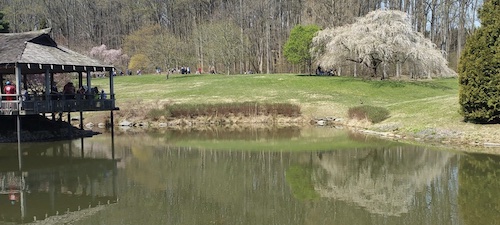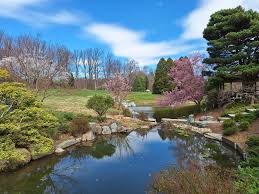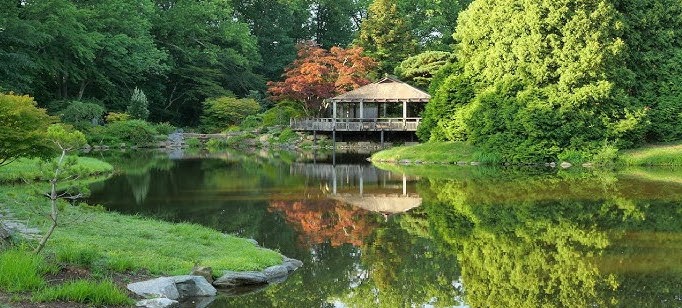A Brookside Gardens Visit – Sustainability in Gude Stroll Garden
by Lynne Pieri-Finn, Fairfax Master Gardener
On April 15, 2024, I joined one of the Earth Month tours offered at Brookside Gardens in Wheaton, Maryland. The talk was on sustainability; specifically, how native plants and good land stewardship are implemented in the Gude Stroll Garden. The Gude is a Japanese-style garden with cascading ponds and rolling hills.
I met Josh Demers, Horticulturist, and the group at the Visitors Center. After checking in, we proceeded slowly up the path into a broad open space of the Gude Garden. This is a remarkable place, full of peace and serenity unlike the hustle and bustle of Montgomery County. People walked about in groups, enjoying the garden. The day was glorious with a blue sky and white, puffy clouds.
 We descended the grassy hills surrounding the pond, where Josh told us about his trouble with storm water runoff, a common problem with the frequent, heavy downpours in our area that leave little time for rainfall percolation into the soil. He showed us where water rushes down from high on the hill, puddles in a little valley, then moves forward and down to the pond. The challenge Josh faces is finding a solution in keeping with the essence of the Japanese garden. In the end, a pleasing swale was built near the ponds edge down to the water. To direct the water into the swale was not so easy, so a perpendicular foot-high wall in pleasing stones and plantings of juniper and other low growing evergreens was added and fit into the overall serene feel of the place.
We descended the grassy hills surrounding the pond, where Josh told us about his trouble with storm water runoff, a common problem with the frequent, heavy downpours in our area that leave little time for rainfall percolation into the soil. He showed us where water rushes down from high on the hill, puddles in a little valley, then moves forward and down to the pond. The challenge Josh faces is finding a solution in keeping with the essence of the Japanese garden. In the end, a pleasing swale was built near the ponds edge down to the water. To direct the water into the swale was not so easy, so a perpendicular foot-high wall in pleasing stones and plantings of juniper and other low growing evergreens was added and fit into the overall serene feel of the place.
Josh’s other goal in management of the Gude is to maintain selection of plants commonly used in Japanese gardens while adding native plants to fill the roles of otherwise nonnative plants. There were the usual cherries, Japanese maples and cryptomeria, but Josh recently designed and installed a new section of the nearby Viburnum Garden, incorporating many native shrubs such as American Hollies (Ilex opaca ‘Maryland Dwarf’) and blueberry cultivars. Groundcovers such as a low delicate creeping sedum (Sedum ternatum) and a low growing grassy plant Grass-leaf Sweet Flag (Acorus gramineus) round out the space.
Almost all of the trees and shrubs are labeled with both the common and Latin name throughout the garden. This way, you can replicate that same plants in similar conditions in your own garden. When I found a plant of interest, I snapped a photo of the plant and the nameplate.
 Moving down to the pond, Josh showed us further efforts to shore up the banks of the pond in order to keep sediment from entering the water. Brookside is sensitive to the need of turtles and frogs to have easy access to the water, but areas where geese commonly enter need to be partially blocked off. The geese are too bothered about jumping over a recently installed low barrier of recycled hardy plank. Some places are free and clear of obstacles; others use locally sourced stones (Carderock stone) pounded in vertically. Boulders of various shapes and sizes line the pond. Josh noted that future planting of trees and shrubs behind the plank would hide it from view, but to me, it fit in with the overall theme.
Moving down to the pond, Josh showed us further efforts to shore up the banks of the pond in order to keep sediment from entering the water. Brookside is sensitive to the need of turtles and frogs to have easy access to the water, but areas where geese commonly enter need to be partially blocked off. The geese are too bothered about jumping over a recently installed low barrier of recycled hardy plank. Some places are free and clear of obstacles; others use locally sourced stones (Carderock stone) pounded in vertically. Boulders of various shapes and sizes line the pond. Josh noted that future planting of trees and shrubs behind the plank would hide it from view, but to me, it fit in with the overall theme.
In other areas, grasses (such as Hakonechloa macra) were planted to stabilize pond banks, but the geese have started nibbling on the tender, newly emerging foliage. Algae blooms, caused by stormwater runoff into the pond and large amounts of goose excrement, coupled with increased temperatures in the summer are a recurring challenge. Josh showed us where he and his team wade into the upper pond area to remove excessive underwater grasses that muck up the water flow and add to the density of the pond bottom.
 After an hour and a half of lecture and discussion in the heat of day, I retreated to the Visitors Center. No food or drink are permitted at Brookside, so I remembered to bring my big water bottle, but it was in the car. After a brief look in the gift shop, I headed across the parking lot, made of permeable pavement that absorbs rain and prevent runoff, to eat my bagged lunch and to drink water.
After an hour and a half of lecture and discussion in the heat of day, I retreated to the Visitors Center. No food or drink are permitted at Brookside, so I remembered to bring my big water bottle, but it was in the car. After a brief look in the gift shop, I headed across the parking lot, made of permeable pavement that absorbs rain and prevent runoff, to eat my bagged lunch and to drink water.
After my break, I retreated to the Azalea Garden, a lovely forest of dappled sunlight and shade. There were so many paths to choose from; I took the one down to the brook and thought about the name of the garden: Brookside. The path then wound up to the right and once more I was climbing the shady hill. Benches were placed here and there for rest and enjoyment; people sat quietly or read a book. It was so peaceful and soul inspiring.
The ground was covered with all types of shade perennials; I was struck by the huge leaves on a reddish tinged Hosta. It was a beauty, sitting there in the light. Naturally, I remembered the high metal fence around the whole garden, protecting it from deer. Delicate Japanese painted ferns (Athyrium niponicum var. pictum) at the edge of the path and tall ostrich ferns (Matteuccia struthiopteris) graced my way through. Hellebores were everywhere. I was amazed to see a Florida Anise Tree (Illicium floridanum) in full bloom, the red flowers hanging down gracefully.
And, of course, azaleas were in every color: soft white, pale lilac, pinky rose and bright orange-red. A young man asked me to take his photo in front of some pink azaleas, and I was happy to help. I smiled when he tracked me down again to take another set in front of the red ones.
After another stop in the Visitors Center to browse the gift shop and enjoy the beautiful watercolors lining the walls, I headed back to my car. It was just starting to rain — a perfect end to a perfect day. Thank you, Josh, for the wonderful tour. Check out some other adult programs and events in Brookside’s Cultivate Magazine.